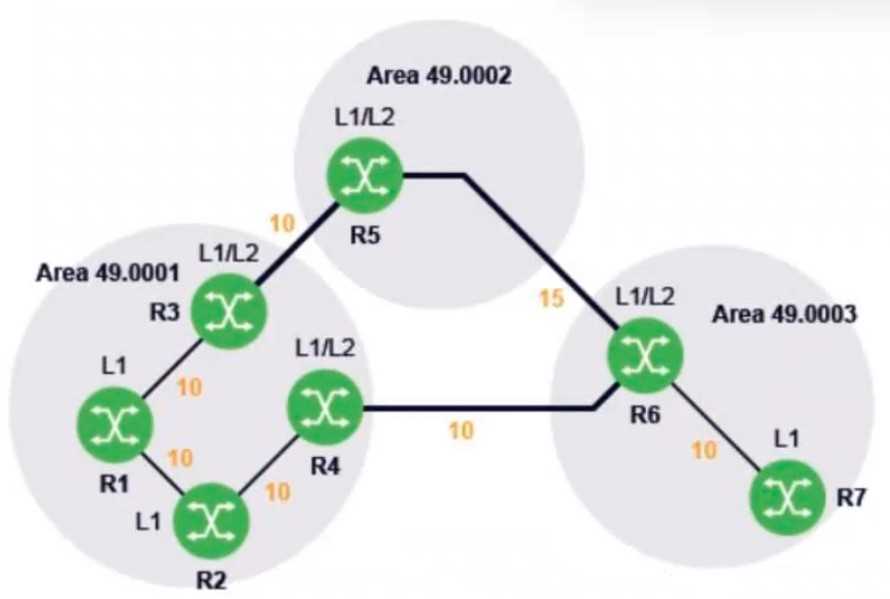nokia 4A0-112 Exam Questions
Questions for the 4A0-112 were updated on : Nov 21 ,2025
Page 1 out of 3. Viewing questions 1-15 out of 40
Question 1
A series of actions are triggered on a router as a result of enabling both loopfree-alternate for a link-
state routing protocol and ip-fast-reroute. Which of the following is NOT one of those actions?
- A. Calculating the shortest-path next hop for each known IP prefix.
- B. Calculating a backup next hop for each known IP prefix, if it exists, that would not create a routing loop if used without informing other routers.
- C. Installing two entries in the FIB for IP prefixes, one active and one in standby mode.
- D. Enabling the router to locally repair the active path to an IP prefix in case of failure.
Answer:
A
Question 2
When using IS-IS in native mode for routing in a dual-stack IPv4/IPv6 environment, which of the
following statements is FALSE?
- A. All links are assumed to be IPv4- and IPv6-capable.
- B. The same topology information is used to calculate the shortest path tree for both IPv4 and IPv6.
- C. In a multi-area environment, the SPF algorithm needs to be run four times on each L1/L2 router.
- D. It may lead to traffic black-holing if not properly designed.
Answer:
C
Explanation:
In a dual-stack IPv4/IPv6 IS-IS environment, the SPF (Shortest Path First) algorithm is only run once
per router for each protocol (IPv4 or IPv6). The topology is shared, but the SPF calculations for IPv4
and IPv6 are separate. This means that the SPF algorithm will run twice (once for IPv4 and once for
IPv6) for each L1/L2 router, not four times.
Question 3
Refer to the exhibit.
In the IS-IS network shown, router R1 has been configured to summarize subnetworks 20.20.1.0/24
and 20.20.2.0/24 as 20.20.0.0/16. Which routers’ routing tables will be reduced, compared to their
routing tables before the summarization?
- A. Router R1
- B. Router R2
- C. Routers R1 and R2
- D. Routers R2 and R4
Answer:
B
Explanation:
Router R1 is the one that performs the summarization of the two subnets (20.20.1.0/24 and
20.20.2.0/24) into the summarized route 20.20.0.0/16. However, R1 itself will not see any change in
its routing table because it is directly connected to both subnets and already knows about them.
Router R2, which is in Area 49.0002, will benefit from this summarization because it previously had
separate routes for both 20.20.1.0/24 and 20.20.2.0/24. After the summarization, R2 will only need
to maintain a single route to 20.20.0.0/16, reducing the size of its routing table.
Router R4 does not directly benefit from the summarization because it is only connected to the Level
1 network and has no need for the summarized routes from R1. Thus, the summarization does not
affect R4's routing table.
Question 4
Consider the exhibit.
All routers are running IS-IS with IPv6 support enabled. Based on the topology shown, and the route
tables of routers R3 and R4, which of the following statements is TRUE?
- A. There is no route leaking configured on router R1 or router R2.
- B. Route leaking is configured on router R1 but not on router R2.
- C. Route leaking is configured on router R2 but not on router R1.
- D. Route leaking is configured on both routers R1 and R2.
Answer:
D
Explanation:
From the route tables of R3 and R4, we can see that remote routes are present, with R3 and R4 both
having routes referencing routers in different areas (Area 49.01 and 49.02). These remote routes are
characteristic of route leaking, which is the process of sharing routes between different IS-IS areas.
R3 has routes for R1, R2, and R4, which are in Area 49.01, suggesting that R1 and R2 have advertised
their routes to R3, possibly due to route leaking.
R4 has similar routes for R2 and R3, indicating that R2 might have advertised its routes to R4.
This sharing of routes between areas is indicative of route leaking being configured on both R1 and
R2, allowing these routes to be shared across the areas.
Question 5
Consider the exhibit.
All routers are running IS-IS with IPv6 support enabled. Based on the topology shown, and the route
tables of routers R3 and R4, which of the following statements is TRUE?
- A. There is no route leaking configured on router R1 or router R2.
- B. Route leaking is configured on router R1 but not on router R2.
- C. Route leaking is configured on router R2 but not on router R1.
- D. Route leaking is configured on both routers R1 and R2.
Answer:
D
Explanation:
Based on the IPv6 route table output for R3 and R4, we can see that the routers have remote routes
listed as "Remote ISIS", indicating that the route is being advertised from a different area (area 49.01
or 49.02). This is a sign of route leaking, where routes from one area are being shared across areas.
The routes from R3 (level-1 router) are being advertised to R4 (level-1 router), and vice versa, with
ISIS as the protocol. This implies that there is route leaking configured to allow information to pass
between areas.
Question 6
A new router is added to a broadcast network. What does IS-IS use as the tiebreaker for selecting the
DIS if the priorities are the same?
- A. The router with the highest system ID.
- B. The Hello packet with the highest sequence number.
- C. The existing DIS remains the DIS.
- D. The router with the highest interface MAC address.
Answer:
A
Explanation:
In IS-IS, the Designated Intermediate System (DIS) is responsible for certain tasks on broadcast
networks, such as generating link-state advertisements and acting as the central point for flooding
information.
Question 7
There are several differences between IS-IS Hello packets used on broadcast interfaces and on point-
to-point interfaces.
Which of the following statements is FALSE?
- A. On broadcast interfaces there are different Hello packet types for level-1 and level-2 adjacencies, whereas on point-to-point interfaces there is a single Hello packet type.
- B. The multicast MAC addresses to which the Hello messages are sent are different on broadcast interfaces and on point-to-point interfaces.
- C. The neighbors are identified using their interface MAC addresses on broadcast Hello messages and using their system IDs on point-to-point Hello messages.
- D. Broadcast Hello messages identify the elected designed IS (DIS) and point-to-point Hello messages do not.
Answer:
C
Explanation:
In both broadcast and point-to-point interfaces, IS-IS routers identify neighbors using system IDs, not
interface MAC addresses. The system ID is a unique identifier assigned to each router, and it is used
to identify neighbors in both types of interfaces.
Question 8
An IS-IS router receives a CSNP that references an older LSP than the one in its local database. What
action is taken?
- A. The router sends a copy of the referenced LSP from its database to its neighbor.
- B. The router sends a CSNP to its neighbor describing the newer LSPs in its database.
- C. The router updates its database with the new sequence number and floods a copy of the LSP to its other neighbors.
- D. The router sends a PSNP to its neighbor to request a copy of the LSP.
Answer:
A
Explanation:
When a router receives a CSNP (Complete Sequence Number PDU) that references an older LSP
(Link-State PDU) than the one in its local database, it indicates that the neighbor is missing newer
information.
In response, the router sends back a PSNP (Partial Sequence Number PDU) to the neighbor, which
includes a copy of the LSPs it has in its local database that the neighbor may not yet have. This helps
to synchronize the link-state information between routers.
Question 9
Refer to the exhibit.
Examine the physical topology of the IS-IS network, the metrics of the links and the levels of the
routers. All routers have their system interfaces included in IS-IS. Which of the following statements
describes the route-table entry that router R4 will use to reach the system IP address of router R6?
- A. Router R4 will have a route to router R6’s system IP address with router R2 as the next-hop.
- B. Router R4 will have a default route with router R2 as the next-hop.
- C. Router R4 will have a default route with router R3 as the next-hop.
- D. Router R4 will not have a matching entry in its routing table for router R6’s system IP address.
Answer:
A
Explanation:
Router R4 is in Area 49.0001 and R6 is in Area 49.0002. Both routers are Level 2 (L2), meaning that
they can communicate across areas using Level 2 IS-IS routing.
Since R2 is the L1/L2 router that connects both Area 49.0001 and Area 49.0002, it will be the next-
hop for router R4 to reach R6’s system IP address.
The IS-IS protocol will ensure that R4 will have a route to R6’s system IP address via R2 as the next-
hop.
Question 10
Refer to the exhibit.
Routers R1 through R4 in the diagram have established IS-IS adjacencies. Router R1 is L1/L2 and is
the DIS of its two broadcast interfaces. How many LSPs will it generate?
- A. 2
- B. 3
- C. 4
- D. 5
Answer:
B
Explanation:
Router R1 is configured as L1/L2, meaning it is part of both Level 1 and Level 2 IS-IS routing areas.
This means R1 will generate two types of LSPs:
Level 1 LSP (for the local area 49.0001) to advertise its local topology to other Level 1 routers.
Level 2 LSP (for the backbone area 49.0002) to advertise the global network topology to Level 2
routers.
R1 also has two broadcast interfaces, and as the Designated Intermediate System (DIS) on these
interfaces, it will generate an LSP for each interface (one per broadcast link).
This results in three total LSPs:
A Level 1 LSP for the local area (49.0001).
A Level 2 LSP for the backbone area (49.0002).
An LSP for each of the two broadcast interfaces, which may include interface-related topology
information.
Question 11
Refer to the exhibit.
Which of the following statements best describes the IS-IS domain to which the command output
corresponds?
- A. Single-area IS-IS domain with no broadcast interfaces.
- B. Multi-area IS-IS domain with no broadcast interfaces.
- C. Single-area IS-IS domain with broadcast interfaces.
- D. Multi-area IS-IS domain with broadcast interfaces.
Answer:
D
Explanation:
The output shows two levels of IS-IS databases: Level 1 (L1) and Level 2 (L2). This indicates that the
domain is multi-area, as L1 routers are confined to a single area, while L2 routers can route between
different areas. The presence of Level 1/Level 2 (L1/L2) routers also suggests that the domain spans
multiple areas.
The LSP (Link-State PDU) entries show L1/L2 ATT attributes, which typically indicate that these
routers are capable of routing both within their own area (Level 1) and across areas (Level 2),
suggesting a multi-area design.
The IS-IS domain likely includes broadcast interfaces, as indicated by the "ATT" attribute (typically
referring to the type of interface) and common IS-IS configuration practices on broadcast networks
like Ethernet.
Question 12
Two IS-IS neighboring routers are trying to establish an adjacency, but the interface has been
configured as broadcast on one of them and as point-to-point on the other. Why is the adjacency not
established?
- A. The routers do not agree on the result of the DIS election.
- B. The routers discard the received Hello messages because they are not the expected type: LAN Hello vs point-to-point Hello.
- C. The routers do not receive each other’s Hello messages because they listen for messages transmitted to different multicast MAC addresses.
- D. The routers do not receive each other’s Hello messages because they listen for messages transmitted to different multicast IP addresses.
Answer:
B
Explanation:
IS-IS routers use different types of Hello messages depending on whether the interface is configured
as a broadcast (LAN) or point-to-point (P2P) link.
On a broadcast network (e.g., Ethernet), IS-IS routers use LAN Hello packets to establish adjacencies.
On a point-to-point link, IS-IS uses point-to-point Hello packets.
If one router is configured for a broadcast interface and the other for point-to-point, they will
exchange incompatible Hello packets, and as a result, neither router will accept the other's Hello
messages, preventing the adjacency from being established.
Question 13
A router is trying to establish an IS-IS adjacency with the DIS on a broadcast link. What event causes
the adjacency to change from “Initializing” to “UP”?
- A. Receiving a Hello packet from the DIS that contains the local router’s own MAC address in the neighbor list.
- B. Receiving the first CSNP packet from the DIS that lists the LSPs in the DIS’s link-state database.
- C. Receiving a CSNP packet from the DIS acknowledging the last transmitted LSP.
- D. Receiving the last LSP requested from the DIS.
Answer:
B
Explanation:
The process of establishing an IS-IS adjacency on a broadcast link involves several steps, and the
transition from the Initializing state to the UP state occurs when both routers exchange sufficient
information to confirm they have a consistent view of the link-state database.
The CSNP (Complete Sequence Number PDU) packet is used to advertise the list of LSPs in the
router's link-state database. When a router receives the first CSNP from the DIS (Designated
Intermediate System) that lists the LSPs in the DIS's database, it indicates that the router has enough
information to establish the adjacency and synchronize its database.
Question 14
On a broadcast interface, an IS-IS router receives an LSP that is newer than the one on its database.
Which of the following statements best describes the actions taken by the router as a consequence?
- A. The router sends back a copy of the LSP from its database to its neighbor.
- B. The router updates its database with the LSP and floods a copy to its neighbors on other interfaces.
- C. The router updated its database with the LSP, acknowledges the LSP with a PSNP, and floods a copy to its neighbors on other interfaces.
- D. The router updates its database with the LSP and acknowledges it with a PSNP.
Answer:
C
Explanation:
When an IS-IS router receives a newer LSP (Link-State PDU) than the one already in its database, it
takes the following actions:
Updates its link-state database with the new LSP.
Acknowledges the LSP with a PSNP (Partial Sequence Number PDU), which is sent to the router that
originated the LSP, confirming the receipt of the newer LSP.
Floods a copy of the updated LSP to its neighbors on other interfaces to ensure all routers in the
network have the updated topology information.
Question 15
Refer to the exhibit.
In the diagram, all routers are using IS-IS as their routing protocol. The number next to each link is its
metric value.
What path will traffic follow from router R1 to router R7, and from router R7 to router R1?
- A. Router R1 to router R7 will follow (R1-R2-R4-R6-R7). Router R7 to router R1 will follow (R7-R6-R4- R2-R1).
- B. Router R1 to router R7 will follow (R1-R2-R4-R6-R7). Router R7 to router R1 will follow (R7-R6-R5- R3-R1).
- C. Router R1 to router R7 will follow (R1-R3-R5-R6-R7). Router R7 to router R1 will follow (R7-R6-R4- R2-R1).
- D. Router R1 to router R7 will follow (R1-R3-R5-R6-R7). Router R7 to router R1 will follow (R7-R6-R5- R3-R1).
Answer:
A
Explanation:
From R1 to R7: The path will be R1 → R2 → R4 → R6 → R7 because this path has the least cumulative
metric of 10 + 10 + 10 + 10 = 40.
From R7 to R1: The reverse path will follow R7 → R6 → R4 → R2 → R1 because it is the shortest
return path with the same metrics.